Inquivix HQ
1-903, 18 Eonju-ro 146-gil,
Gangnam-gu, Seoul, Korea
06057
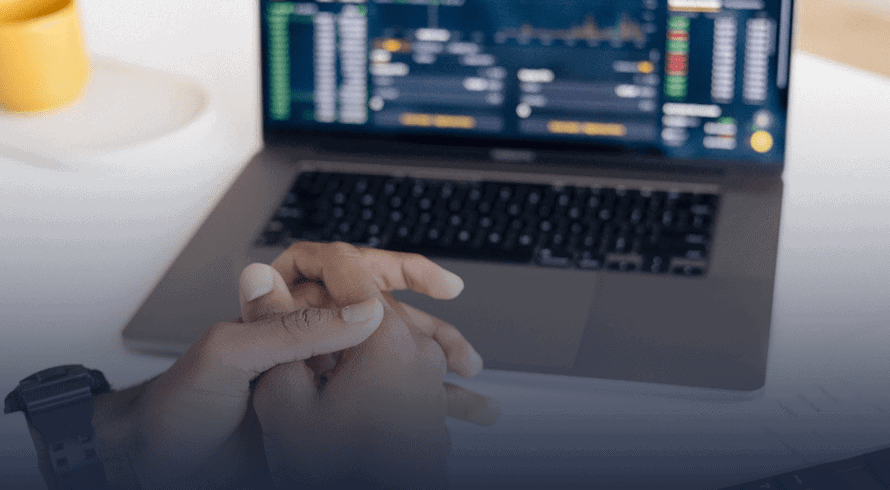
Have you ever heard of the anchoring effect? It’s one of the most intriguing concepts in marketing. If you’re not familiar with it, the anchoring result is a cognitive bias. Anchoring is the process of focusing your potential buyer on an offer or price by leading them to believe this is their best option. The anchor can be any number of things including price, size, selection, name recognition, or other feature. Sellers will typically provide an anchor that would be perceived as a compelling value in the eyes of the buyer.
You might want to offer something at a lower price than you plan on charging in order to get your customer hooked before revealing information about prices for larger purchases. If you do not want to give them what they think is their best option, you should create some urgency by making it appear like other customers are interested in buying it right away.
How Does the Anchoring Effect Work?
The anchoring effect works by first presenting a price and then stating a higher price. The higher price will be considered by shoppers as closer to the original, lower price than the other prices offered. This pricing strategy is applied in marketing and negotiations and can significantly affect how much people pay for something.
In other words, rather than relying on a solid judgment to arrive at the most remarkable conclusion overall, we ‘anchor’ our decision-making process to the current situation through the anchoring effect. This has a variety of applications in marketing, and we’ll go through them here.
Psychological Factors
The psychological make-up of the consumer is a significant influence on buying behavior. These factors are tough to quantify, but they have enough power to shape a purchase. The following are some vital psychological influences.
Motivation
Motivation has an impact on a customer’s purchasing behavior. A person has numerous requirements, including social needs, fundamental needs, security demands, self-esteem, and self-actualization desires. The primary and security needs come out on top, owing to their significance. As a result, fundamental and safety requirements can persuade customers to purchase goods and services.
Perception
Customer perception is the process by which a customer gathers information about a product and interprets that information to construct an image of a specific company’s goods or services. The consumer’s viewpoint may become clouded when their initial research fails to compare different choices before purchasing, leading to dissatisfaction with one’s purchase. A consumer’s impression about a product is formed when they see advertisements, coupons, customer evaluations, social media feedback, and so on. As a result of this, consumers’ perceptions impact their purchasing decisions.
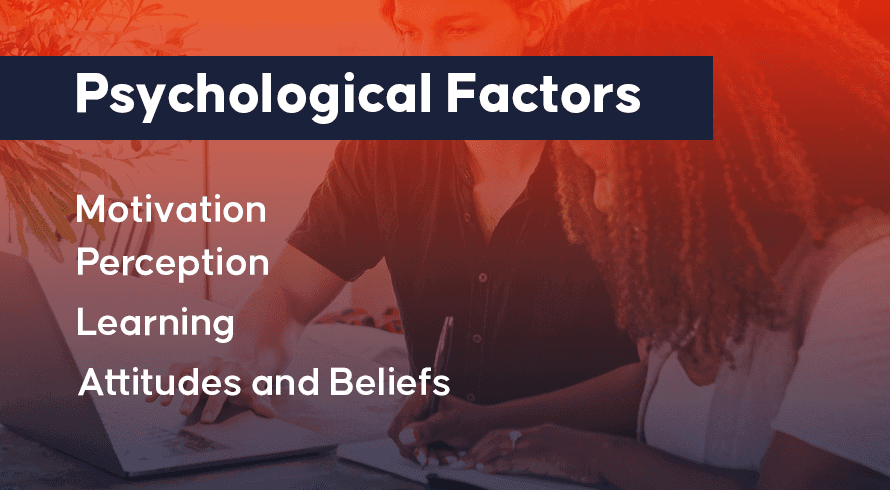
Learning
Learning is engaging when a consumer purchases a product. They are introduced to additional information about it. Humans tend to learn through experience gradually over time. A consumer’s education is based on talents and understanding. While the practice may help you develop your skill, you can only acquire knowledge through experience. The learning process can be either reflective or proactive. The consumer is confronted with a scenario repeatedly in this sort of conditioning, resulting in an opinion about it.
Attitudes and Beliefs
Consumers have a variety of attitudes and beliefs that influence their purchasing decisions. The consumer has a certain mood for the product due to this view. The customer’s perspective has a significant effect on the brand image. As a result, marketers try to comprehend customers’ attitudes to create marketing campaigns.
Social Factors
Humans are social creatures, and they live in close proximity to other people who have an impact on their purchasing decisions. Studies in applied social psychology suggest that people attempt to imitate one another and desire to be accepted by society as a whole. As a result of this, their buying habits are also influenced by others around them. The following factors fall under the category of social influences.
Family
The family has a significant impact on how people shop. A person’s preferences are molded during the formative years, and he continues to purchase the same items as an adult, even if they change.
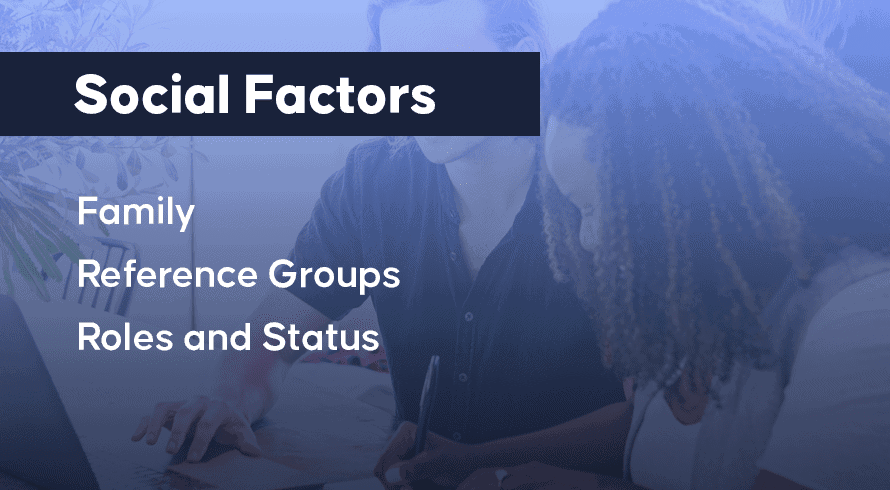
Reference Groups
Reference groups are a collection of individuals with whom a person identifies himself. The majority of the people in the reference group share similar purchasing habits and impact one another.
Roles and Status
A person’s position in society impacts his purchasing behavior. His status would significantly influence the buying habits of a person who is in a high-ranking position. Due to his stature, a Chief Executive Officer (CEO) will have distinct purchasing behaviors than a worker or employee at the same firm.
Cultural Factors
A person’s economic behavior is affected by their cultural background. A group of individuals is linked to a particular community’s principles and ideas. When an individual comes from a specific community, their actions are strongly influenced by the culture associated with them. The following are some cultural aspects through which a person sets a reference point for buying behavior.
Culture
Cultural factors strongly influence consumer buyer behavior. The fundamental values, preferences, perceptions, and behaviors that a consumer learns about from their close relatives and other vital people in their lives are known as cultural factors.
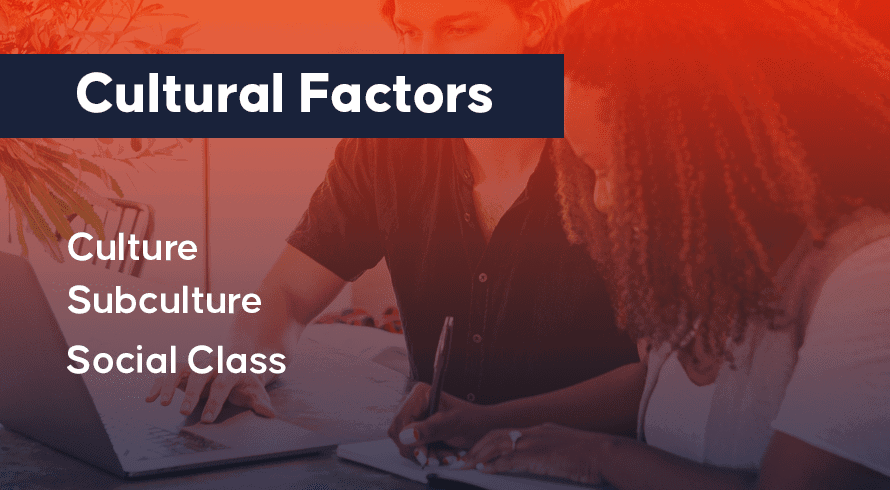
Subculture
Within a culture group, there may be many subcultures. These subcultural collectives have the same values and beliefs as one another. Subcultures can include people from diverse religious, social, economic, and cultural backgrounds. Cognitive psychology studies suggest that a customer segment, formed by a subculture, shares similar purchasing behaviors.
Social Class
Social class is a concept that exists in every society on the planet. Social classes exist, and they are not simply based on income. Other items such as profession, family background, education level, and residence location all influence social class. It’s critical to understand how social class influences consumer behavior in making decisions to use anchoring effects.
Personal Factors
Personal aspects that are unique to customers influence their purchasing decisions. Individual differences vary from person to person, resulting in varied perceptions and consumer behavior. The following are some examples of individual factors.
Age
The ages of 9 through 24 are found to have the most significant influence on consumer lifestyles. The buying preferences of youngsters differ significantly from those of middle-aged people. Elderly individuals have a distinct shopping pattern that varies considerably from teenagers’. Middle-aged people are more concerned with home, property, and automobiles for the family whereas younger consumers are mostly influenced by first impressions.
Income
Income has the power to influence a person’s purchasing habits. Consumers with more significant financial resources have more purchasing power. When customers have higher disposable income, they have more opportunities to spend on high-end items. On the other hand, low-income and middle-income consumers devote most of their money to necessities like food and apparel.

Occupation
Occupation has an impact on a customer’s purchasing habits. A person is more likely to purchase items compatible with their job. A doctor, for example, would buy clothes following her profession, while a professor might have a distinct shopping pattern.
Lifestyle
Lifestyle is a way of living and an attitude that people may or may not adopt. A consumer’s lifestyle has a significant impact on his purchasing habits. For example, if a customer lives a healthy lifestyle, his purchases will be associated with nutritious alternatives to fast food.
Economic Factors
The economic situation of a country or market significantly influences consumer buying patterns and decisions. Because the economy is strong, there is more money in the market and greater consumer purchasing power when a nation is prosperous. Consumers are more willing to spend when they have confidence in an improving economic climate. An unstable economy reflects ailing market conditions influenced by unemployment and reduced purchasing power. The following are some of the most significant economic factors.
Personal Income
When a person’s disposable income rises, so does their purchasing power. Disposable income is the money left after fulfilling a person’s necessities. When there is an increase in disposable income, purchases on various items rise. However, when disposable income decreases, the expenditure on many things likewise declines.
Family Income
The total money brought into the family by its members is known as family income. More employed people in the household means more money to purchase necessities and luxuries. Increased family earnings encourage family members to consume more. When extra cash is available for the home, it becomes easier to acquire luxury goods that a person wouldn’t have been able to afford otherwise.
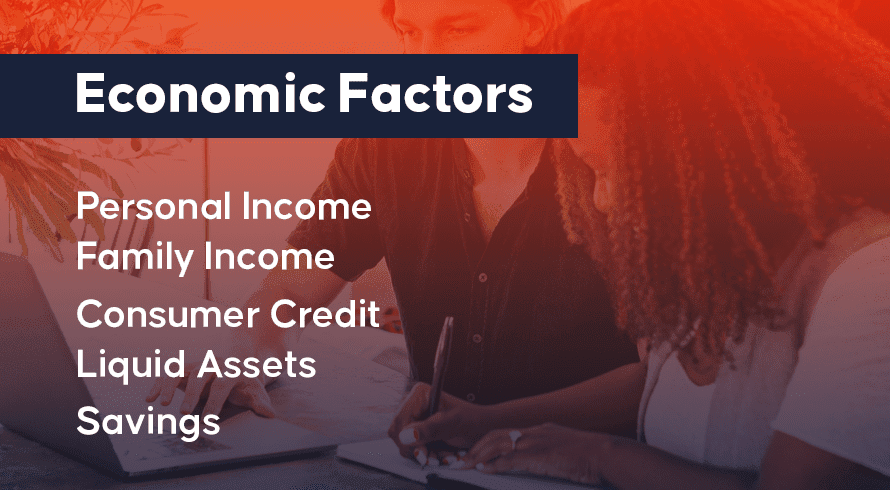
Consumer Credit
When a customer is provided with a simple credit to acquire items, their expenditure increases. Sellers are making it as convenient as possible for customers to obtain credit through credit cards, easy payments, bank loans, hire purchases, and other similar loan alternatives. When consumers have more access to credit, they are more likely to purchase.
Liquid Assets
Consumers who have liquid assets, on average, spend more on comfort and pleasures. Liquid assets are those that people may readily convert to cash. Cash in the bank, savings accounts, and securities are examples of liquid assets. It gives a consumer greater confidence to buy premium items with higher liquid assets.
Savings
The amount of money a consumer wishes to save from their income significantly impacts their purchasing decisions. If the consumer decides to have more savings, their spending on purchases decreases. When a person is interested in saving more, most of their expenditure will be on necessities and not luxuries.
Impact of Anchoring Effect in Marketing on Your Business
People rely too heavily on information they’ve been given at the beginning of an article or discussion to make judgments later on. Psychologists have shown that this bias works because we often need to develop an initial value for something so fast that we don’t think carefully about it or analyze it critically. Our brains will automatically use the first piece of information it comes across as the basis for an estimation.

How to Use the Anchoring Effect to Market Better?
The anchoring effect is one of the most powerful and widely documented cognitive biases. It’s also called the focal point and can be found in many fields ranging from economics to psychology and marketing. Anchoring is when our expectation for a particular value is influenced by something irrelevant but external to what we’re judging or deciding on.
The Anchoring Effect in Your Business
When we first start our businesses, we’re all starting on equal footing, and we should operate that way regardless of what others have accomplished or how many mistakes they’ve made in the past. If your business is still new, don’t fall into the trap of thinking that you can’t compete with another company simply because they have more money, time, or human resources. The only thing your colleagues have over you is experience, and even then, it’s just one piece of a huge puzzle that needs to be solved. Look at every opportunity as equal to everyone involved, regardless of what has happened in the past.
The anchoring effect is a cognitive bias that makes people not want to go with the flow. The anchoring effect can make people feel like they are always at a disadvantage and never able to succeed. If you think this way, you must take some time to step back and evaluate where these thoughts come from and any truth behind them. Remember that every business and project was created on a blank slate and will be treated as such.
What Is Anchoring Bias?
Anchoring bias is when consumers are too influenced by pre-existing beliefs. People who tend to rely heavily on first impressions show signs of anchoring bias. They hardly change their minds even after a better option is presented to them.
Take a customer who sees a product with a $1000 first, and then sees a product similar in every aspect but considerably low priced at $200. Then the customer sees the second product as cheaper. The first price, the anchor price, influenced their perception of the price. This is an example of anchoring bias.
Conclusion
The anchoring effect is a cognitive bias that influences a person’s decision-making. It occurs when people rely too heavily on the first piece of information they receive when deciding. This can impact a person’s buying behavior by causing them to make irrational decisions. Anchoring often occurs in sales situations. Salespeople can try to anchor a customer with an initial price that is too high, then negotiate the person down until they are willing to buy at the desired final price point. Marketers also need to be aware of the anchoring effect because it may impact their target customers’ decision-making.
